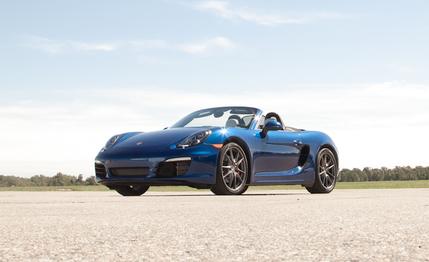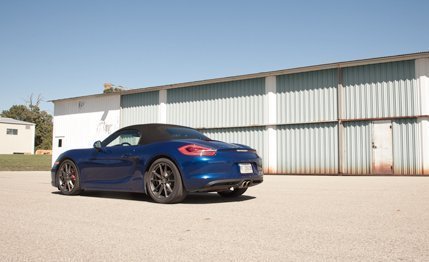 Instrumented Test
Instrumented Test

For those of you who might have been encased in amber the past 15 years or perhaps stuck in a universe of flying dirigibles, a golden Statue of Liberty, and Sony Betamax VCRs, we’d like to welcome you to the other side. The bad news: During your absence, all the 10-penny mid-engined sportsters such as the Lotus Elise and Toyota MR2 have been superseded by exotics with entomological monikers and six-figure price tags. All, that is, but the Porsche Boxster, which launched around the time you entered hibernation.
By some strange but wonderful evolutionary process, the Boxster has survived—make that thrived—despite a major pandemic of crossover SUVs and self-parking sedans. Or maybe it was simply Porsche’s single-minded determination to develop and refine a relatively affordable—emphasis on “relatively”—mid-engined sports car. We’ve recognized the car’s excellence by placing the Boxster on our 10Best Cars list 13 times since it arrived in 1997.
For 2013, the slightly cherubic, overtly retro skin has molted, replaced by more menacing sheetmetal that’s suggestive of supercars such as Porsche’s own upcoming 918 hybrid. When we first drove the latest Boxster S, we detailed how its innards had metamorphosed as well, with a longer wheelbase, more passenger space, a wider track for more-sure-footed handling, and weight reduction in key areas. A subsequent instrumented test of a six-speed-manual ’13 Boxster S revealed more exotic tendencies—nearly 1.00 g of skidpad grip, a Ferrari 458 Italia–like 147-foot stopping distance from 70 mph, and a 911 Carrera–matching 4.4-second 0-to-60 sprint.

Shift for Brains
For this test, we scrutinized the bestselling version of the Boxster S, which means the model equipped with the Porsche Doppelkupplungsgetriebe, a.k.a. the $3200 dual-clutch PDK automatic. It’s the quickest production 2013 Boxster money can buy, turning in a 4.2-second sprint to 60, 0.2 quicker than the manual car—quicker, even, than the base 911 with its fancy seven-speed manual. It comes by its quickness a couple of ways. Our car had the optional $2370 Sport Chrono package and launch-control setup, which simply storms away more quickly—it’s like sidestepping the clutch in a manual car at 5000 to 6000 rpm—and more consistently. Then there are the PDK’s hyper-quick, Don-Knotts-on-Red-Bull shifts themselves. The PDK has a wider ratio spread than does the manual, with a lower first gear for hard charges off the line.
Beyond its lightning-quick operation, the PDK is almost clairvoyant. Push the Sport Plus button, and the transmission is your little shifting sidekick, one that uncannily knows what your next gear choice will be before you do. Although the PDK does give up the mechanical feel and the organic sports-car sweat equity when you—and you alone—are in control of your gearswaps, there’s something to be said for avoiding the touchy, feely, shifty thing in stop-and-go commuter gridlock. And Porsche’s dual-clutch box will keep you fairly entertained even when you manage to find a traffic-free stretch of serpentine asphalt. We still prefer driving with the stick—Save the Manuals!—but we have little issue with anyone who opts for the PDK.